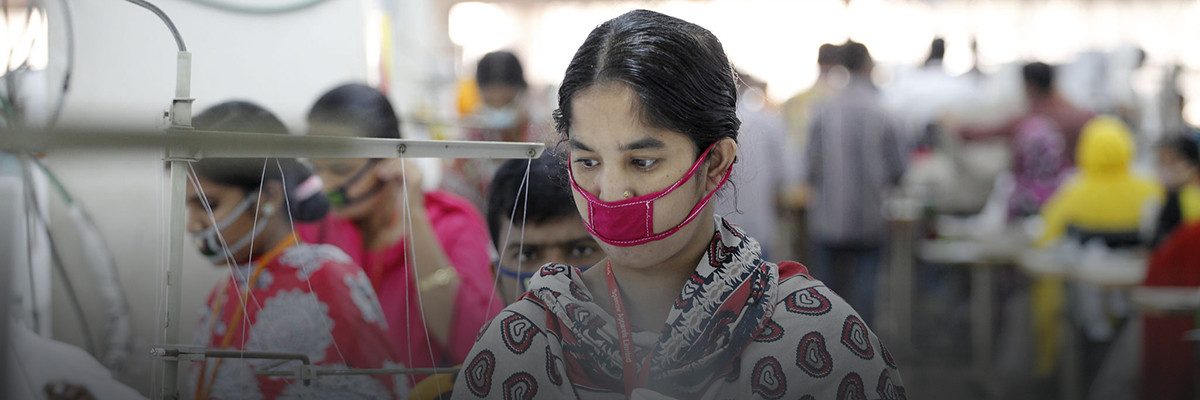
Photo credit: ILO in Asia and the Pacific, Better Work Programme. Flickr.
Authors
-
Marat Yu
Former Manager, BSR
Five years ago, a building housing a garment factory in Dhaka, Bangladesh, collapsed, killing 1,134 people. The deadliest structural failure in modern human history, the Rana Plaza tragedy turned the eyes of the world to Bangladesh and sparked a conversation about compliance and building safety.
Since then, brands and the development community have come to acknowledge that the workplace presents an opportunity not just to strengthen safety norms, but to address the needs of workers more broadly. Workplaces today are so much more than physical structures: They are places of opportunity for an income, and they are spaces for change.
This recognition has led to an increased focus on women workers and the particular challenges they face—and addressing these challenges begins with listening to women. BSR’s HERproject has been working in Bangladesh since 2010. By bringing together brands, their suppliers, and local partners, HERproject has been able to drive significant progress through workplace-based training and guidance. In total, HERproject has reached 240,000 women workers in 165 Bangladeshi factories since 2010. As one example of the impact this has had, HERproject has measured a 49 percent increase in Bangladesh in the number of women using sanitary pads during menstruation, which reduces the possibility of infection, across 10 factories.
However, major challenges remain. Almost 60 percent of female garment workers in Bangladesh have experienced some form of physical or verbal violence at work. Women workers also often lack basic health information and access to healthcare, which has a negative impact on their working and personal lives (only 45 percent of Bangladeshi women are using a modern contraceptive method). Occupational segregation and discriminatory social norms continue to ensure that women remain anchored in low-paying production jobs.
The Rana Plaza tragedy stimulated progress, with organizations working to address building infrastructure and give workers a voice. Through the Accord on Fire and Building Safety in Bangladesh, brands have invested heavily in the modernization of supplier factories. As another example, the Alliance for Bangladesh Worker Safety has provided a helpline for workers to report issues anonymously.
We believe that brands, suppliers, and the development community can do four things to further the empowerment of women workers:
- Listen and respond to the voice of women workers. This means collecting quantitative and qualitative data on worker well-being to inform the design of programs, including on the knowledge and agency that women may possess and lack. It also means rigorously measuring the impact of programs and revising them based on the evolving needs of women.
- Make women’s empowerment part of business as usual. Both suppliers and brands can put women’s empowerment at the heart of business processes. Factories involved in HERproject, for instance, are working to revise healthcare systems to ensure that they work for women. Through its recent WE Women initiative, Lindex is incorporating gender equality into its supplier business scorecard, thereby according preference to suppliers that demonstrate commitment to women’s empowerment. The ascena Retail Group has also worked with BSR to revise its Code of Conduct for suppliers. These efforts suggest that resources should be allocated to ensure gender considerations are included in management systems.
- Support suppliers to increase ownership. For gender equality to take hold, factory managers must understand and own the change process. Brands can accelerate this by acknowledging that a “one-size-fits-all” approach will not be sufficient. Rather than delivering one-off projects, brands and suppliers should work together to build the capacity of factory managers, support them in setting goals, and drive sustainable long-term progress.
- Don’t go it alone—collaborate. Many challenges, such as sexual harassment or cash wage payments, stem from social norms and policies. Tackling these effectively will require forming alliances to create an enabling ecosystem. In Bangladesh, brands and suppliers can begin to tackle sexual harassment and gender-based violence by working together to operationalize the High Court Order to establish anti-harassment committees. They can also collaborate to advocate for and implement digital payrolls, which are particularly beneficial to women workers.
Women still make up the majority of the workforce in ready-made garment factories in Bangladesh. On the fifth anniversary of Rana Plaza, it is critical to ensure that the needs of women workers remain a key consideration for companies looking not just to ensure basic safety, but also to improve the welfare and well-being of their workers.
Collaborative Initiatives
Let’s talk about how BSR can help you to transform your business and achieve your sustainability goals.